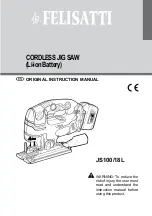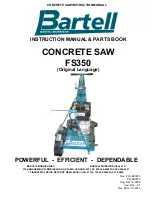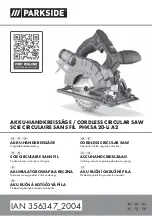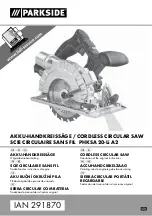
table size. . . . . . . . . . . . . . . . . . . . . . . . . 500 x 335mm
dust extraction Ø . . . . . . . . . . . . . . int.35mm,ext.40mm
sound power level . . . . . . . . . . . . . . . . . . . . 85.3 dB(A)
sound Pressure level . . . . . . . . . . . . . . . . . . 72.3 dB(A)
Input voltage. . . . . . . . . . . . . . . . . . . . . . . . 230V - 50Hz
motor power . . . . . . . . . . . . . . . . . . . . . . . . . . .600watts
saw Blade Ø . . . . . . . . . . . . . . . . . . . . . . . . . . . 200mm
Arbor Ø. . . . . . . . . . . . . . . . . . . . . . . . . . . . . . . . . 16mm
no load speed . . . . . . . . . . . . . . . . . . . . . . . . . 2950rpm
max depth of 90o cut . . . . . . . . . . . . . . . . . . . . . 42mm
max depth of 45o cut . . . . . . . . . . . . . . . . . . . . . 25mm
duty cycle. . . . . . . . . . . . . . . . . . . . . . . . . . . . . . 30mins
3. SPECIFICATIONS & ASSEMBLY
3.1
MOUNTING THE SAW
.
I
f the saw is to be bolted to a workbench you should ensure that it is
in the most convenient position for use with sufficient clearance from nearby walls and other
features to allow you to handle and cut the largest pieces of sheet and timber you require.
3.1.1 If the saw is not to be permanently fixed in one location it should be mounted to a stout piece
of board in order to give the saw stability in operation. the board should be not less than
450 x 600mm and be at least 15mm thick. to mount the saw, drill four 5mm holes at the
dimensions shown shown in fig.A. or place the saw onto the board and mark the fixing
positions through the mounting holes.
3.1.2 use 4mm bolts to fix the saw to the board. tighten the bolts progressively to avoid distorting
the saw frame. do not over tighten the bolts. Before using the saw ensure that it is securely
clamped to a strong workbench with at least two ‘G’cramps. check that these remain tight at
all times whilst using the saw. ensure that the work area has adequate lighting.
WARNINg!
ENSuRE THE SAW IS NOT CONNECTED TO THE MAINS POWER bEFORE
COMMENCINg ASSEMblY.
3.2
Rip fence assembly and adjustment.
( see fig.2 item 4 ) the saw is supplied with a rip fence cutting guide which is essential to
achieve a straight cut when cutting in the same direction as the grain of the wood.
3.2.1 to assemble the fence to the support table first loosen the clamps at either end of the fence by turning the clamping knobs ( see item
9 in figs.1 & 2 ) anticlockwise. the fence can be positioned on either side of the blade to suit the size and width of the timber being
cut.
3.2.2 Place the guide at one side of the table, parallel to the blade, and slide the clamps onto the table so that the loose part of each clamp
is on the inside of the front and back edges of the table.
3.2.3 Position the guide at the required distance from the blade using the two scales inset into the surface of the table. each end of the
guide must be set on the scale at the same distance from the surface of the blade. this is essential to ensure that the guide is parallel
to the blade. double check this before proceeding to cut.
3.3
Mitre block.
A mitre block is supplied to aid cutting at 90° and 45° to the blade. When required the mitre block should slide onto the
lower part of the rip fence guide as shown in fig.2 item 3.
WARNING!
ensure saw is switched off & disconnect from the mains power before making adjustments or setting saw.
4.1
ON/OFF SWITCH
(see fig.1 item 7)
for normal operation push the
“l“
button for on and the
“0“
for off. the saw is fitted with an on/off switch of the ‘no volt release’
type. this means that if the power fails or is disconnected whilst the machine is in use, the machine will not restart automatically when
the power is restored. In this situation it will be necessary to restart the saw by pressing the
“l“
for on button again.
4.2
DUST EXTRACTION PORT.
WARNING!
Wood dust can be harmful to health by inhalation and skin contact and concentrations of small dust particles in the air can
form an explosive mixture. Ensure there is adequate ventilation.
the saw is fitted with a dust extraction port (see fig.2 item 8). for safe operation we recommend that a suitable dust extraction device
or vacuum cleaner is connected during operation. never allow an excess of sawdust to accumulate on the saw, especially around the
motor.
WARNING!
Excessive sawdust build up around the motor could possibly ignite causing injury to yourself and damage to the saw and
its surroundings.
4.3
BLADE GUARD
(see figs.1&2 item 2)
WARNING!
Ensure saw is switched off & disconnected from
the mains power before making any adjustments.
the blade guard is designed to be self closing. When not in use
the front edge of the guard should be resting on the table. As
the workpiece is pushed towards the blade the sloping front
edges of the guard will ride up and over the workpiece. As the
workpiece moves past the blade the guard will drop down
again. (the guard retaining knob should not be done up tight as
this would restrict the automatic movement of the guard). on
the right hand side of the guard there is a sliding plate which
offers additional protection when the blade is tilted (see fig.3)
WARNING!
The blade guard must be in place during all
cutting operations. The saw is not designed to produce
through grooves,
stopped grooves or rebating. Do not attempt to modify or adapt
the saw in any way or use any other manufacturers
accessories.
4.4
BLADE TILT CONTROL
the blade can be tilted to cut any angle up to 45
°
for both rip
and cross cutting. firstly loosen the two blade tilt locking knobs.
(see figs.1&2 item 10) to tilt the blade begin to wind the blade
tilt handle (see fig.1 item 6) anticlockwise until the blade
reaches the desired angle which can be read from the angle
scales adjacent to each locking knob. then re-tighten both locking knobs. see tilted blade in fig.3.
4. ADJUSTMENT & SETTINGS
fig A.
fig 3.
Original Language Version
Hts8 Issue: 2 - 2/11/09























